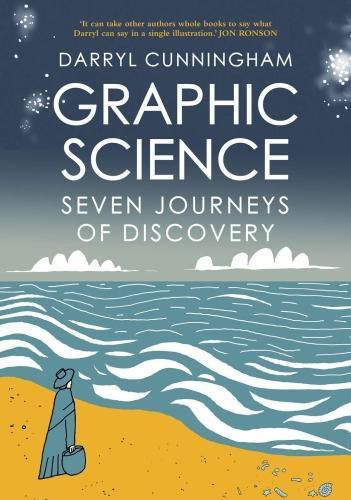Readings Newsletter
Become a Readings Member to make your shopping experience even easier.
Sign in or sign up for free!
You’re not far away from qualifying for FREE standard shipping within Australia
You’ve qualified for FREE standard shipping within Australia
The cart is loading…






Much is known about scientists such as Darwin, Newton, and Einstein, but what about lesser known scientists - people who have not achieved a high level of fame, but who have contributed greatly to human knowledge? What were their lives like? What were their struggles, aims, successes, and failures? How do their discoveries fit into the bigger picture of science as a whole? Overlooked, sidelined, excluded, discredited: key figures in scientific discovery come and take their bow in an alternative Nobel prize gallery.
Antoine Lavoisier: the father of French chemistry who gave oxygen its name, Lavoisier was a wealthy man who found himself on the wrong side of a revolution and paid the price with his life.
Mary Anning: a poor, working-class woman who made her living fossil-hunting along the beach cliffs of southern England. Anning found herself excluded from the scientific community because of her gender and social class. Wealthy, male, experts took credit for her discoveries.
George Washington Carver: born a slave, Carver become one of the most prominent botanists of his time, as well as a teacher at the Tuskegee Institute. Carver devised over 100 products using one major ingredient - the peanut - including dyes, plastics and gasoline.
Alfred Wegener: a German meteorologist, balloonist, and arctic explorer, his theory of continental drift was derided by other scientists and was only accepted into mainstream thinking after his death. He died in Greenland on an expedition, his body lost in the ice and snow.
Nikola Tesla: a Serbian American inventor, electrical engineer, mechanical engineer, physicist, and futurist best known for his contributions to the design of the modern alternating current (AC) electricity supply system. A competitor of Edison, Tesla died in poverty despite his intellectual brilliance.
Jocelyn Bell Burnell: a Northern Irish astrophysicist. As a postgraduate student, she discovered the first radio pulsars (supernova remnants) while studying and advised by her thesis supervisor Antony Hewish, for which Hewish shared the Nobel Prize in physics while Bell Burnell was excluded.
Fred Hoyle: an English astronomer noted primarily for the theory of stellar nucleosynthesis - the process whereby most of the elements on the Periodic Table are created. He was also noted for the controversial positions he held on a wide range of scientific issues, often in direct opposition to prevailing theories. This eccentric approach contributed to him to being overlooked by the Nobel Prize committee for his stellar nucleosynthesis work.
Any one of these figures could have been awarded a Nobel prize. Not every scientific discoverer was lauded in their time, for reasons of gender, race, or lack of wealth, or (in the case of Lavoisier) being too wealthy: in the 21st century, there are many more reparations and reputations to be made.
$9.00 standard shipping within Australia
FREE standard shipping within Australia for orders over $100.00
Express & International shipping calculated at checkout
Much is known about scientists such as Darwin, Newton, and Einstein, but what about lesser known scientists - people who have not achieved a high level of fame, but who have contributed greatly to human knowledge? What were their lives like? What were their struggles, aims, successes, and failures? How do their discoveries fit into the bigger picture of science as a whole? Overlooked, sidelined, excluded, discredited: key figures in scientific discovery come and take their bow in an alternative Nobel prize gallery.
Antoine Lavoisier: the father of French chemistry who gave oxygen its name, Lavoisier was a wealthy man who found himself on the wrong side of a revolution and paid the price with his life.
Mary Anning: a poor, working-class woman who made her living fossil-hunting along the beach cliffs of southern England. Anning found herself excluded from the scientific community because of her gender and social class. Wealthy, male, experts took credit for her discoveries.
George Washington Carver: born a slave, Carver become one of the most prominent botanists of his time, as well as a teacher at the Tuskegee Institute. Carver devised over 100 products using one major ingredient - the peanut - including dyes, plastics and gasoline.
Alfred Wegener: a German meteorologist, balloonist, and arctic explorer, his theory of continental drift was derided by other scientists and was only accepted into mainstream thinking after his death. He died in Greenland on an expedition, his body lost in the ice and snow.
Nikola Tesla: a Serbian American inventor, electrical engineer, mechanical engineer, physicist, and futurist best known for his contributions to the design of the modern alternating current (AC) electricity supply system. A competitor of Edison, Tesla died in poverty despite his intellectual brilliance.
Jocelyn Bell Burnell: a Northern Irish astrophysicist. As a postgraduate student, she discovered the first radio pulsars (supernova remnants) while studying and advised by her thesis supervisor Antony Hewish, for which Hewish shared the Nobel Prize in physics while Bell Burnell was excluded.
Fred Hoyle: an English astronomer noted primarily for the theory of stellar nucleosynthesis - the process whereby most of the elements on the Periodic Table are created. He was also noted for the controversial positions he held on a wide range of scientific issues, often in direct opposition to prevailing theories. This eccentric approach contributed to him to being overlooked by the Nobel Prize committee for his stellar nucleosynthesis work.
Any one of these figures could have been awarded a Nobel prize. Not every scientific discoverer was lauded in their time, for reasons of gender, race, or lack of wealth, or (in the case of Lavoisier) being too wealthy: in the 21st century, there are many more reparations and reputations to be made.